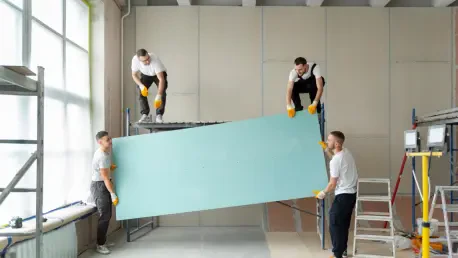Listen to the Article
The built environment contributes roughly 25% of the UK’s annual emissions. In 2021 alone, the construction sector generated over 10 million metric tons of CO₂. Yet, demand for buildings continues to grow. Alongside this growth, energy requirements from the sector are also projected to rise by 50% by 2050. This trajectory forces a shift, and the industry is exploring new approaches to reduce carbon impact across the construction lifecycle.
This is just one brick in the entire construction industry. The other facade is also showing cracks. Supply chain disruptions and global trade conflicts drive volatility in 2025’s construction material costs, elevating copper, aluminum, and nickel prices, which compels contractors to update estimates continuously with real-time market data to maintain budget accuracy.
With these challenges in mind, innovative decision-makers are increasingly favoring modular construction. This new approach enables them to meet their sustainability goals without breaking the bank.
So, what constitutes modular construction? How does it really benefit the industry? And should your business walk the same path? This article will help you answer these questions. Discover more about modular construction and determine if it’s the right foundation for your next project.
What Is Modular Construction?
In essence, modular construction assembles buildings from repeated, standardized modules fabricated off-site under controlled factory conditions. The work includes structural, mechanical, and finish work before sections are transported for rapid on-site assembly. All fabrication and installation must strictly adhere to modern building codes, regulations, and quality standards to guarantee compliance and performance.
Grand View Research projects the global modular construction market to reach USD 162.42 billion by 2030, expanding at a 7.9% CAGR from 2025 to 2030 due to infrastructure growth and building projects in developing economies. Rapid urbanization and industrialization in commercial and industrial sectors will drive new developments worldwide, while technology advances and benefits such as accelerated schedules, lower costs, enhanced flexibility, material reuse, and reduced waste underpin rising industry demand.
Moreover, modular construction minimizes material waste and ensures consistent compliance with building standards. As sustainability mandates intensify and cities densify, designers leverage modular methods to deploy high-end residences and expansive commercial complexes with faster turnaround and scalable quality. This positions modular design as the cornerstone of future building strategies.
Many Setbacks Abound
Modular construction has potential drawbacks and challenges that demand careful evaluation and strategic planning. It limits architectural variety because mass-producing identical modules maximizes cost and schedule efficiencies at the expense of unique design details. In addition, the transportation of large sections still incurs significant expenses and logistical hurdles.
Not only that, but traffic delays, height restrictions, and narrow roads can erode off-site savings, while customization options remain constrained, forcing design teams to work within standardized dimensions rather than tailoring modules to specific site conditions or customer needs.
More pressingly, persistent skepticism about modular construction quality and durability stems from past failures and widespread misconceptions, as 43% of industry professionals report lingering doubts. The scarcity of high-profile case studies showcasing sustainable, high-performance projects fails to build stakeholder confidence, while cultural resistance amplifies community apprehension and impedes market integration.
Lastly, navigating modular construction logistics demands meticulous coordination and strategic planning. This is to prevent costly delays when large prefabricated modules move on specialized vehicles along carefully plotted urban routes and assemble on sites whose inconsistent conditions and limited access otherwise threaten on-schedule completion.
Will the Benefits Outweigh the Drawbacks?
Environmentally, the construction industry is one of the largest contributors to global degradation. Traditional construction consumes excessive energy, depletes raw materials, and produces large volumes of waste when crews cut materials on-site.
Modular methods, on the other hand, shift measuring, cutting, and assembly to controlled factories to minimize scrap and recycle off-cuts. And as modular construction expands, specialist builders apply sustainable fabrication methods to reduce embodied carbon in modules while companies implement energy-efficient design standards to minimize operational energy use. These eco-friendly practices transform sustainability into a strategic asset by attracting clients who value environmental impact.
Modular construction transforms building by shifting fabrication of major structural components into controlled factory settings. This eliminates weather-related delays, centralizing quality control under one fabricator instead of multiple site teams, and accelerating delivery when clients demand rapid occupancy.
When it comes to housing affordability, urban housing costs now outpace wage growth, with home prices skyrocketing by 47% since early 2020. This leaves many without affordable options, and modular construction addresses this gap by streamlining factory fabrication and reducing build times. This also helps cut expenses while maintaining quality standards, enabling delivery of safe, cost-effective housing at scale.
Modular construction shifts most tasks into factory settings with controlled environments that shield workers from weather hazards, heavy machinery, and high-risk outdoor activities while enabling a focus on precision and craftsmanship. It lowers injury rates, reduces accident-related delays, cuts developer liability, and elevates overall worker safety and stakeholder confidence.
How the Modular Approach Affects Industry Professionals
Modular construction transforms the design process by requiring front-loaded planning that aligns on-site foundation work with factory fabrication. This means that architects, engineers, and contractors must finalize detailed module designs early to avoid costly midstream changes.
Design for Manufacture and Assembly anchors every decision, optimizing modules for factory production and seamless on-site integration by accounting for transportation dimensions. This methodology also unlocks innovation through scalable repetition (such as mirrored apartment units) that ensures quality consistency and accelerates production.
To ensure success, professionals must evolve collaboration from the project’s inception. Architects, engineers, contractors, and manufacturers must operate as a single team that uses tools like Building Information Modeling to coordinate structural elements. This prevents miscommunication, avoids delays, and ensures every module fits precisely into the final assembly.
Final Thoughts
The modular approach delivers a sustainable alternative to traditional construction by cutting carbon impact and unlocking operational efficiencies.
Modular construction is moving from niche to mainstream as its sustainability, efficiency, and technological capabilities align with industry priorities. Strategic investments in automation, workforce training, and circular design will entrench it as a foundational method for future projects. Despite upfront cost and cultural barriers, early adopters stand poised to lead a global market set to redefine construction norms by 2030.
It’s critical that businesses embrace a modular approach to maintain excellence in the future of construction.









